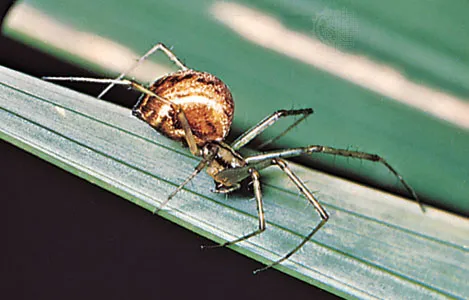Sheet-Web Weavers: The Subtle Architects of the Understory:The family Linyphiidae, commonly referred to as sheet-web weavers or money spiders, comprises over 4,700 described species worldwide, making it the second-largest spider family after Salticidae. These diminutive arachnids, typically measuring less than 6 mm in length, are often overlooked due to their size, yet they are among the most prolific web-builders in the Northern Hemisphere.(Wikipedia)

Their webs are characterized by horizontal, sheet-like structures, often accompanied by dome- or cup-shaped modifications. The spiders usually reside on the underside of these webs, sometimes positioning themselves between two layers of silk. For instance, the hammock spider (Linyphia phrygiana), native to North America, constructs a distinctive hammock-shaped web.
Web Architecture and Prey Capture
Sheet-web weavers exhibit remarkable diversity in web construction, tailoring their designs to their specific ecological niches. Some species spin flat or slightly curved webs that drape over vegetation, rivaling the size of webs created by funnel weavers, albeit lacking the characteristic funnel. These spiders often conceal themselves beneath the web’s edge or within adjacent foliage, poised to ambush unsuspecting prey.
A particularly intriguing member of this family is the bowl and doily weaver (Frontinella pyramitela). This species constructs a complex web comprising a bowl-shaped upper sheet suspended above a horizontal “doily” sheet. The spider typically hangs beneath the bowl, capturing prey that collides with the upper threads and falls into the bowl. Notably, both male and female F. pyramitela are capable of web construction, although females predominantly undertake this task.(Wikipedia, Flickr)
Life Cycle and Reproduction
Linyphiid spiders generally have a lifespan of one year, with some species living only a few months. Females lay eggs in silken sacs, which are often hidden within the web or in leaf litter on the ground. The number of eggs per sac varies by species and individual, ranging from a few to several dozen. These spiders undergo simple metamorphosis; spiderlings resemble miniature adults and grow by molting their exoskeletons.
Reproductive strategies among linyphiids vary. Some species mate and lay eggs year-round, while others have specific mating seasons. Both eggs and adults can overwinter, and certain species continue to build webs and capture prey during colder months.

Ecological Significance
Linyphiid spiders are among the most prevalent arthropod predators in agricultural ecosystems. Their webs are commonly found attached to trees, grasses, fence posts, leaf litter, and even directly on the soil. These spiders feed on a variety of insects and other arthropods, including springtails, flies, aphids, leafhoppers, and even other spiders.
Web construction typically occurs at night, sometimes requiring several consecutive nights to complete. Once established, a spider may inhabit the same web for several days or longer. Due to the substantial silk investment, linyphiids do not relocate their webs as frequently as orb-weaving spiders.

Dispersal via Ballooning
A notable behavior among linyphiid spiders is ballooning—a dispersal method where spiders release silk threads to catch the wind and travel through the air. This behavior is common not only among spiderlings but also adult linyphiids, facilitating rapid colonization of new habitats. While ballooning allows for extensive dispersal, it also carries risks due to unpredictable landing sites and environmental conditions.
Human Interaction and Agricultural Impact
Linyphiid spiders are not considered pests and pose no known threat to humans. On the contrary, they are beneficial in agricultural settings, preying on common crop pests such as aphids and leafhoppers. Their presence in crop fields contributes to natural pest control, reducing the need for chemical interventions.
Diversity in Kentucky
Kentucky hosts a diverse array of linyphiid species, many of which are identifiable only through microscopic examination. While few species have common names, their ecological roles are significant, contributing to the control of pest populations and the overall health of ecosystems.
